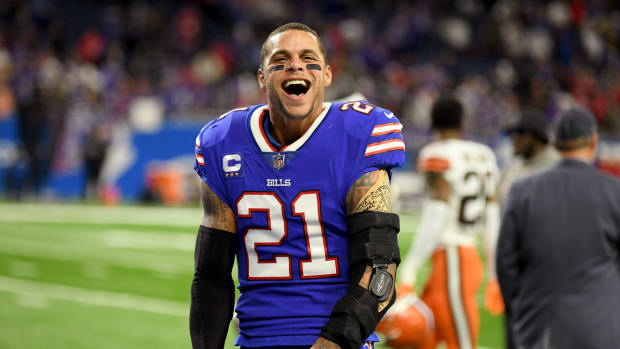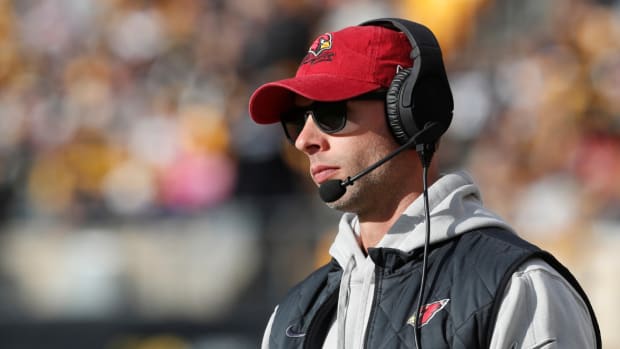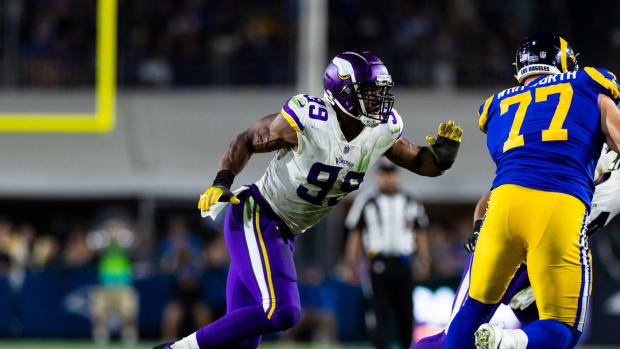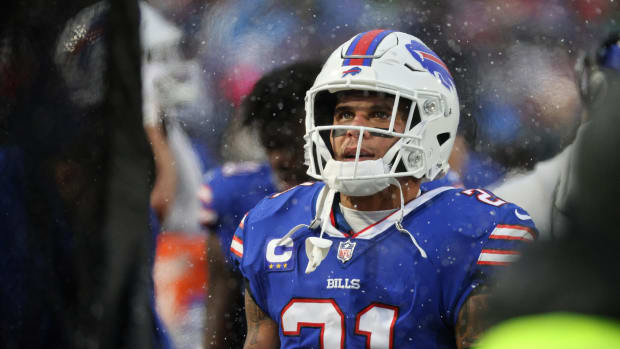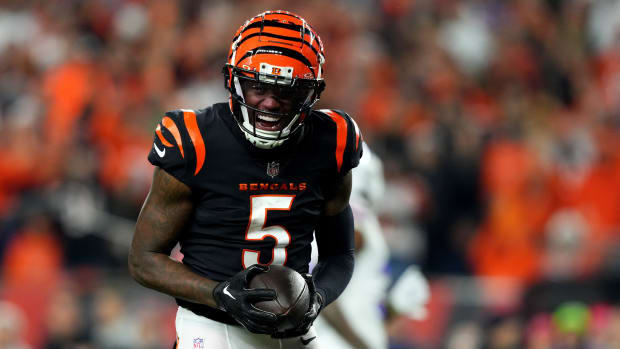After Ryan Shazier, a Strengthened Emphasis on Tackling Technique
Two months ago in Cincinnati, Steelers linebacker Ryan Shazier approached Bengals receiver Josh Malone on a shallow crossing route and drove in to make the tackle. As he closed in on Malone, Shazier lowered his head, and when his helmet made contact with Malone’s thigh pads, Shazier collapsed to the ground, grabbing for his lower back.
“You’re going to see Shazier break on the ball, and he went in there with his head down, and that’s never good a thing,” Jon Gruden said during the initial replay on ESPN’s Monday Night Football broadcast. As medical staff attended to Shazier, Gruden added, “It’s really been the talk of the league—you never go in there with the crown of the helmet. Try to keep the helmet out of tackling. All you can do is hope and pray that Ryan Shazier is okay.”
Shazier suffered what was termed a spinal contusion, and underwent spinal stabilitization surgery on Dec. 6. Over the ensuing weeks, the football world has followed his treatment and therapy with sympathy and concern, greeting each new social media post or appearance at a Pittsburgh sporting event with cautious optimism. He was discharged from the University of Pittsburgh Medical Center rehabilitation institute on Feb. 1, and, as he acknowledged in response to a Twitter post by Michelle Tafoya on Super Bowl Sunday, he is now able to stand and walk, but only with assistance. His long-term prognosis has not been discussed.
Gruden got it right in the first few seconds after the play, before the severity of Shazier’s injury was evident. The star linebacker’s technique—ducking his head at the moment of full-speed contact with the receiver—is likely what caused his injury. Like many players of his generation, Shazier has an established tendency to lower his head when making tackles, and he had made similar tackles hundreds of times in his football career.
His blindside helmet-to-helmet hit that knocked out Bengals running back Giovani Bernard in the 2015 AFC wild-card game prompted the NFL to outlaw such hits. Search for YouTube highlights from any stage of Shazier’s football career, and you can find evidence of his going in head-first. Knowing that Shazier is now working to regain the ability to walk independently, such clips are difficult to watch.
In the fall The MMQB visited a number of high school teams across the country as part of our Football in America series. After the Shazier injury, we reached out to four coaches from those teams, each of whom is actively trying to coach the head-first tackling technique out of the game.
Jerry Veshio of Quaker Valley High in Sewickley, Pa., just outside Pittsburgh, felt sick when he saw the Shazier injury. “It nauseated me,” he says. “As a coach, that’s your worst nightmare, to have a player go down like that and have a life-threatening, debilitating injury.”
After Veshio worked through the initial terror and said a few prayers for Shazier, he began to consider what this situation might mean for young football players. “I think this is definitely a teachable moment,” Veshio says. “Any time you have a negative incident, as a teacher—and coaches are teachers—you have to make people aware, so others don’t make the same mistake.”
In Euless, Texas, Chris Jensen, coach of Trinity High, was also watching. “That is just a what-not-to-do,” he says of the Shazier tackle. “Head down, he’s not seeing what he hits anyway.”
Erik Hermanson, head coach at Cleveland High, in Cleveland, Minn., says, “The frustrating thing, is he has a couple steps, and he could get ready and just make a great form tackle, but instead he is trying to deliver a blow, trying to knock the ball free. If he just wraps him up there … ”
At South Pointe High in Rock Hill, S.C., the four-time state champs rarely tackle to the ground during practice. All eight of the team’s coaches went through USA Football’s Heads Up Football training program, and they stress tackling and blocking using the shoulders instead of the head. They’ve even changed the way they teach making an angle tackle. The old instruction was to tell a defensive player to think about shooting their head across the front of the ball carrier or receiver. “We don’t even do that now,” Southe Pointe head coach Strait Herron says. “We teach to use the shoulder and attack the back hip, and to grab and hold on like crazy, use your weight to pull the guy down.”
At Quaker Valley it’s the same mentality for angle tackles. “We constantly talk about see what you hit, keep that head up and never duck,” Veshio says. “There are greater chances that that ball carrier might get away when you aim for the back hip, but if you do it properly, you are pretty sure that you will make a solid tackle, safely.”
In Texas, Jensen’s players do a tackling circuit without helmets each day at practice, an idea he got from Seahawks coach Pete Carroll, who made an instructional tackling video in 2014. Carroll is a huge proponent of taking the head out of football, and in the video he lays out six types of tackling techniques that are all designed to eliminate head contact. “No helmets makes the kids get the head out of the way—they wrap the legs and twist,” Jensen says. “It is a noticeable difference in games. If you do have an opportunity for a big hit, it’s a shoulder tackle. You can still be physical, there is still some pretty hard contact out there, but the head is not involved.”
Hermanson’s team in Minnesota plays 9-man football. And even with a small team and small coaching staff, Hermanson, another fan of Carroll’s tackling tutorial, tasks one coach with the responsibility of building up tackling technique. Each practice, Cleveland players will break down tackling into basic steps. They start on their knees and pop their hips and throw up their hands, and gradually add on until they are standing and tackling slowly with a partner.
“We’re undersized, so we really stress that we can win every game without ever having a crushing hit,” Hermanson says. “If we just make great form tackles every time we are in position to tackle, and we don’t miss tackles because we are trying to crush someone or trying to take someone out, we will win the game.”
Currently, only two state athletic associations, Oregon and Vermont, require coaches at football-playing member schools to complete USA Football’s Heads Up Football program. Herron, yet another a Carroll-style tackling disciple, believes that appoach must broaden if the game is truly going to become safer. Everyone must buy in for the process to work.
“We are teaching our guys how to tackle better and safer, but you go on to a football field against an opponent and they are coming downhill at you with the top of the helmet, just creaming your kids,” Herron, in South Carolina, says. ”I am hoping that the high school league and the coaches association will get involved. We all need to get on board with understanding how to coach in this modern age more productively.”
Hermanson sees a similar problem in a few of his opponents who haven’t updated their coaching style. “We still play some kind of backwoods teams, where there are coaches screaming on the sideline, Hit higher! Hit harder! Take him out! “ he says. “Stuff you can’t believe someone would say in this day and age.”
Says Veshio, “As a person who coaches young people, you cannot coach that way.”
While it might be too late to reprogram 25-year-old pros of Shazier’s generation, high school coaches have an important job to instill safer technique while players are still young. Jensen thinks real progress has been made already. “The thing we are seeing is these kids, this is the way they have been taught since seventh grade now,” he says. “The guys late in college and in pros, they were brought up in a different era.”
Herron says he’ll point to Shazier in one of the first few team meetings next season as a cautionary tale. “I will use the story to prove a point to our players, to remind them that the helmet is not a weapon, and [using it in such a way] puts them more at risk than the person they are hitting,” he says. “We don’t want to scare the kids, so we have to be careful, but yeah, I could see us using that video clip.”
Jensen thinks showing his players video of themselves making tackles may be even more effective. “We film every practice, every drill, so we are constantly correcting there,” he says. “Praise for a safe tackle, warn them for a dangerous tackle. Kids respond when they see themselves.”
Question or comment? Email us at talkback@themmqb.com.
































